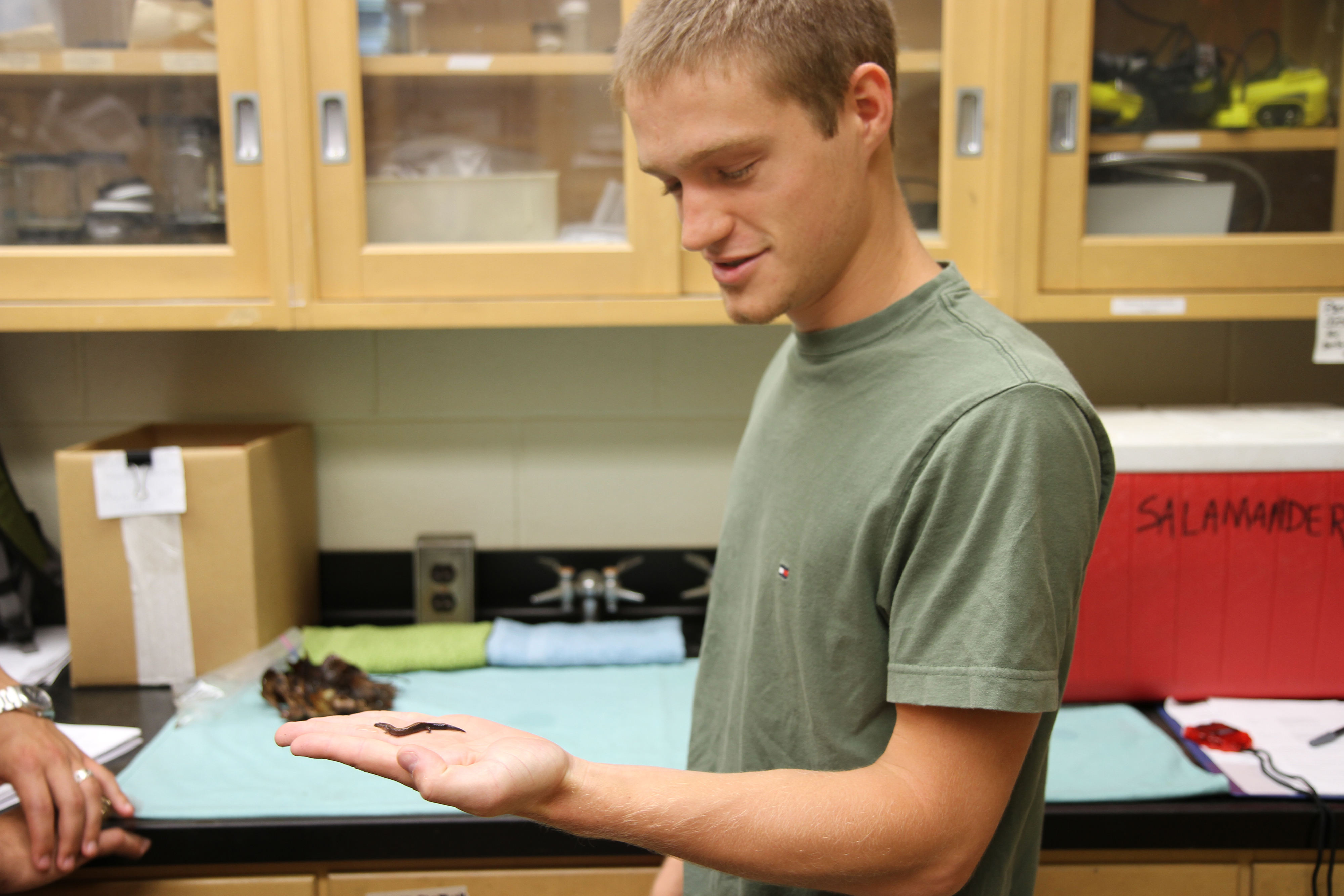Student researchers take a walk on the 'wild' side

What do Florida bog frogs, Loggerhead shrikes, and red-backed salamanders have in common? This summer, the species are being studied by Virginia Tech undergraduate researchers, in hopes that humans might better understand their behaviors and habitat preferences.
Jeronimo Silva of Sao Paulo, Brazil, Alex Garretson of Rockville, Md., and Tyler Williams of Wirtz, Va., all seniors majoring in wildlife science, are working as research assistants to Carola Haas, professor of wildlife ecology. Each received a Summer Undergraduate Research Fellowship (SURF) appointment from the Fralin Life Science Institute.
Silva is studying a bog frog native to western Florida and not known to exist anywhere else in the world. Using mark-and-recapture data collected by other scientists from 2002-03, and again from 2006 to 2008, he employs a computer program called MARK in his Cheatham Hall office to analyze trends in the population over time.
"Florida bog frogs are considered a vulnerable species because they are so endemic," Silva said. "They were discovered in the 1980s and no one knows much about the population, such as whether it is increasing or decreasing." The goal of the project is to estimate the population size and apparent size of the adult frogs, in order to better understand population dynamics.
Meanwhile, Garretson is stationed at the Smithsonian Conservation Biology Institute in Front Royal, Va., where he can observe one of North America’s only captive Logger head shrike populations. Known as the ‘Butcher Bird’ because it skewers its prey on branches or barbed wire before eating it, these song bird populations have declined in the northeastern United States.
"A theory for the decline is the replacement of warm season grass fields to cold season grass fields in the eastern U.S. in the 1950s and 60s, for cattle feeding purposes," Garretson said. "It doesn’t bode well for the birds because they need high nutrient levels in mid-summer."
To test this theory, Garretson is collecting wild grasshoppers (a primary food source of Loggerhead shrikes) from both warm and cool season grass fields. He records the number of grasshoppers he finds in each field and compares their abundance in each grass type, in addition to collecting some grasshoppers for carbon isotope analysis.
Garretson and Haas are interested in analyzing carbon isotope levels of grasshoppers caught in different fields, in order to tell whether the grasshoppers fed on warm or cold season grasses. Garretson is also making behavioral observations of the captive shrike population at the Smithsonian site, and hopes to determine whether there is a difference in foraging success between shrikes hunting in patches of cool season versus warm season grasses.
Lastly, Williams is evaluating a fluorescent powder tracking method used on reticulated flatwood salamanders, which are endangered in Florida due to a decline in the habitat where they lay their eggs. If scientists can determine the everyday behaviors of the salamanders, they might be able to implement conservation practices to help them. Specifically, Williams is testing the addition of mineral oil to the fluorescent powder.
"Mineral oil may offer several advantages, like longer powder retention and increased resistance to moisture, specifically rain," William said. "This is important because reticulated flatwood salamanders are commonly active on rainy or moist nights and that moisture can decrease fluorescent powder tracking abilities."
Williams is testing the method on red-backed salamanders, which are indigenous to Blacksburg.
During the summer of 2012, the Fralin Life Science Institute Summer Undergraduate Research Fellowship (SURF) program and the Division of Undergraduate Education's Scieneering program have banded together to offer an unprecedented number of students — 82 — paid research fellowships. Research appointments, outreach, and group activities are coordinated by Tomalei Vess, director of undergraduate research, and Keri Swaby, Scieneering program manager. For more information, visit the Fralin Life Science SURF website and Scieneering program website.
Related Links
- Undergraduate students explore how electrical stimulation may be able to treat patients with vocal cord paralysis
- Undergraduate student researches methods to regenerate damaged tissue in people and horses
- Undergraduate student researcher investigates bacteria-powered micro-robots as part of Scieneering program







